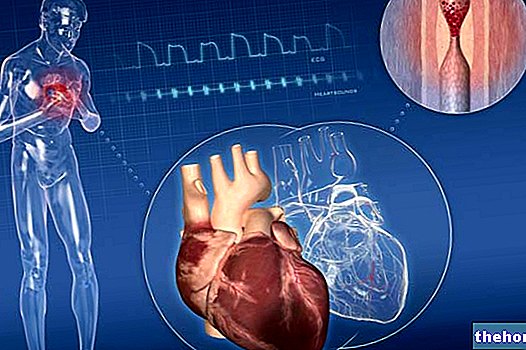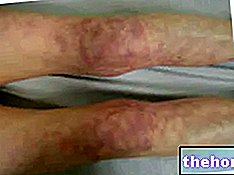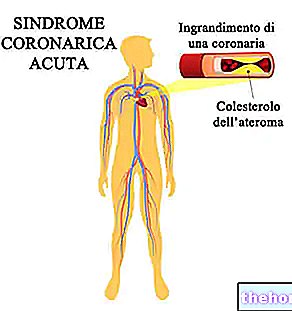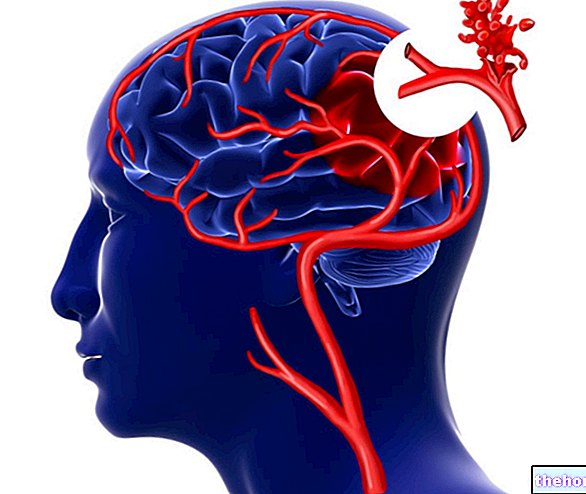Causes
The term left ventricular hypertrophy (IVS) describes the increase in muscle mass of the left ventricle.

In many cases, IVS arises as a long-term compensatory mechanism in response to overload:
- pressure (as happens in hypertensive people and in those who practice power sports, such as weight lifting)
- or volume (as happens in endurance athletes, such as cyclists, marathon runners, swimmers and cross-country skiers).
The heart, in fact, is a muscle and as such can undergo structural changes (hypertrophy, hypotrophy, shortening and lengthening of its fibers) in relation to work and biochemical stimuli (hormones, such as GH, catecholamines, insulin, and enzymes, such as angiotensin II) to which it is subjected.
In other cases, left ventricular hypertrophy is caused by intrinsic factors, such as hypertrophic obstructive cardiomyopathy.
The most common cause of left ventricular hypertrophy is prolonged arterial hypertension. If the peripheral resistances increase, the left ventricle must contract with greater intensity to overcome them, empty itself completely and push the blood to the periphery. This phenomenon, in the long run, causes cardiac changes which, added to the coronary ones induced by hypertension, strongly increase the cardiovascular risk (up to triple it compared to hypertensive subjects but without IVS).
Additional hemodynamic causes of left ventricular hypertrophy are represented by stenosis of the aortic valve (a flap that separates the left ventricle from the aorta, the large blood vessel that carries oxygen-rich blood to various parts of the body) and its regurgitation. Partial obstruction (stenosis) of the aortic or semilunar valve requires a more vigorous contraction of the left ventricle, which is necessary to overcome the resistance offered to its emptying. When regurgitation is present, however, the aortic valve does not close properly and the left ventricle fills more than it should, requiring more effort to pump blood to the periphery.
In patients with previous cardiac infarction, left ventricular hypertrophy is the result of an adaptive response of the heart, implemented to compensate for the function of those muscle areas lacking contractile capacity.
From the morphological point of view, it is usual to distinguish left ventricular hypertrophy into concentric, eccentric and asymmetrical.
- Concentric hypertrophy is the consequence of prolonged pressure overload, which leads to an increase in wall thickness, a reduction in ventricular distension capacity and a reduction in intraventricular diameter. It can be physiological, in response to predominantly isometric power training. or pathological, due, for example, to arterial hypertension.
- Eccentric hypertrophy is the consequence of a prolonged volume overload that leads to an increase in the wall thickness and intraventricular diameter (the thickness / radius ratio does not increase as in the previous case but remains within the normal range).Eccentric hypertrophy recognizes non-pathological causes, as occurs in predominantly isotonic resistance training, or pathological, for example in valve insufficiency, obesity and in the late phase of hypertensive heart disease.
- Asymmetric hypertrophy is characterized by asymmetric septal hypertrophy and is found, for reasons not yet clear, in a small percentage of hypertensive patients.
Symptoms
For further information: Symptoms Left ventricular hypertrophy
Left ventricular hypertrophy tends to develop gradually, and is more common among older and hypertensive people.
Especially in the early stage, it does not cause particular signs or symptoms; when these appear they may include chest pain, palpitations, dizziness, fainting, shortness of breath and reduced resistance to physical exertion.
Treatment and therapy
See also: Drugs for Ventricular Hypertrophy
Just as it happens for our muscles, the phenomenon of left ventricular hypertrophy, secondary to hypertension or duration training is, at least partially, reversible (not always completely because the fibrotic component, typical of IVS of hypertensive origin, regresses with difficulty).
It is therefore essential that the medical treatment of hypertension be started early; better still to intervene in the preventive field, controlling the diet, the level of stress, abolishing smoking and increasing the level of physical activity. In fact, if on the one hand the regression of left ventricular hypertrophy reduces the cardiovascular risk in hypertensive patients, from "Another maintains it at levels that are still higher than those who, despite having high blood pressure, have never suffered from IVS. We must also not overlook the fact that the regression of IVS of hypertensive origin is almost never complete, precisely because of the poor reversibility of the fibrotic component.
In the presence of overt hypertension, therefore, we will intervene with adequate dietary strategies (reduction of salt in the diet) and pharmacological (ACE inhibitors, Angiotensin II receptor antagonists, B-blockers, etc.).
If left ventricular hypertrophy is caused by aortic valve stenosis, surgery may be required to remove it and replace it with one of artificial, animal or human origin. Even in the presence of aortic valve regurgitation, it should be considered. l "surgical repair or replacement.
Role of Sport
With regard to fitness for sports in the presence of left ventricular hypertrophy, the benign origin of the disease must first be assessed, distinguishing it from hypertrophic myocardiopathy (CMI), which represents one of the most common causes of sudden death in young athletes.
The distinction between the two conditions is made by the doctor on the basis of various elements collected during the anamnesis (type of sport practiced, familiarity with the pathology) and the diagnostic tests.
To cite a few examples, an athlete's heart can be distinguished from a heart affected by hypertrophic myocardiopathy by the increase in the ventricular cavity (which can be normal or decreased in the presence of HCM) and by a wall thickness of less than 16 mm (it can be be higher in the presence of CMI).
To confirm his diagnosis, the doctor may request the suspension of the training activity for a few months, in order to assess the degree of reversibility of the left ventricular hypertrophy (if low it is an indication of probable HCM and vice versa).




























